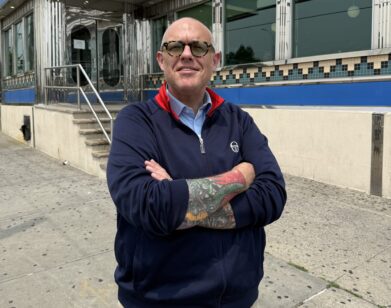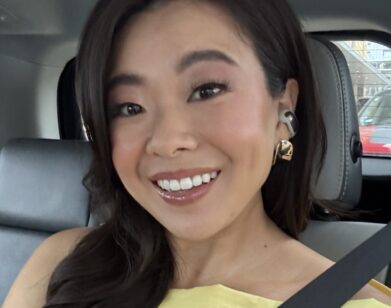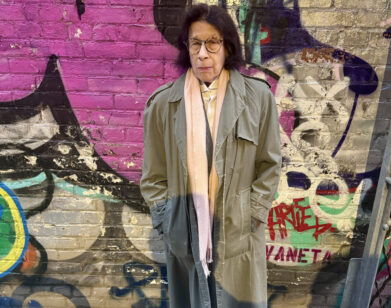closing argument
“Wisconsin Gives Me Gut-Level Heartburn”: Milan Singh, in Conversation With Josh Barro

Illustration by Claudia Buccino.
As we inch closer to one of the most crucial elections of our lifetime, we decided to team up with our friends at Substack, who over the last month have been facilitating dialogues between influential political figures, writers, and commentators. This week, we’ll publish several of those dialogues on the Interview website. The final one, edited for length and clarity below, features journalist and author of the Substack newsletter Very Serious in conversation with Milan Singh, the director of the Yale Youth Poll. Read on for their discussion about swing state forecasts, Trump’s d0wn-ballot acolytes, and the three primary issues driving voters to the polls—and remember to vote!
———
JOSH BARRO: When Substack came to me a few weeks ago to do one of these live conversations, I was thinking about some interesting themes that we’ve seen in the polling and in the campaigns. With Kamala Harris, the polls are suggesting she’s going to run a little bit worse than Joe Biden did four years ago. In particular, she’s showing weakness with non-white voters, especially non-white voters under the age of 50. She’s still winning those groups, but not by nearly the usual margins that you expect for a Democratic candidate. There’s also been this theme of youth discontent with the Gaza encampments, concerns about student debt, housing costs, and climate change. We’re seeing Harris underperforming a little bit with young voters compared to four years ago. So I thought it was good to call the youngest pollster I know, Milan Singh. You might be familiar with Milan. He’s done work with center-left political groups including Blueprint, which is a public opinion research organization trying to push Democrats toward popular campaign messages, especially on the economy. He’s also worked with Welcome Pack, which is a center-left organizing organization. Meanwhile, he’s still an undergraduate at Yale University, where he runs the Yale Youth Poll, which is an undergraduate-run public opinion research operation. So, Milan, thank you for joining me today.
MILAN SINGH: Thanks for having me. It’s a great break from classes.
BARRO: Let’s start by talking about that young, non-white voter swing. It looks like it’s almost this under-50 group where the deterioration is happening. Is that real? And if so, do we have a sense of why it’s happening?
SINGH: In a word, yes. It is real. But if we’re honest in our analysis, we’ve seen Democrats sliding with non-white voters since 2012. We’ve seen Republicans gain ground in racially diverse states like Florida and Texas. You just don’t win Florida by twenty, or even by three-and-a-half in 2020, without making some gains with Hispanic voters.
BARRO: When you say Florida by 20, you mean DeSantis?
SINGH: I think Rubio won by 20, or like 19.5, so a large win. But I think we can break down the reasons for this shift in a couple ways. The big one is generational change, right? The older generation of African-American and Hispanic voters grew up around the Civil Rights Movement, at least as a recent memory. They remember very clearly at that time, the Democrats were the more pro-Civil Rights party and Republicans were less friendly. So if you talk to older African-American voters, they’re pretty staunch Democrats, even if they have somewhat conservative views. The second is you see education polarization. As politics increasingly sorts on [college] degree lines, Democrats are picking up ground with white, college-educated voters and increasingly losing ground with non-college-educated voters.
BARRO: The funny thing about the Trump era and the constant offenses that he creates—we just saw this on Sunday at Madison Square Garden with these comments about Puerto Rico—is that he’s presided over this significant racial depolarization of voting in the United States. He became the physical embodiment of the Republican Party, and the result was that the Republican Party started doing a little bit worse with white people and significantly better with non-white people, which I don’t think is what people expected when he came down the golden escalator in 2015 talking about how Mexico was sending rapists to the United States. In the 2016 results, it hadn’t happened yet.
SINGH: Right. In fact, Hillary did better with Hispanic voters than Obama did. And Democrats, when Obama ran, were getting about 97% of the two-way vote with Black voters. In the long run, that’s not sustainable. I don’t think it’s sustainable for any party to win an ethnic group by that much forever, right? Eventually things are going to kind of revert.
BARRO: I mentioned that Republicans started doing a little bit worse with white voters. One of the big questions for this election is whether that trend is going to continue. Something like 72% of the electorate will be white. The four largest states—California, New York, Texas and Florida—are very diverse, more so than the country as a whole, and none of them are competitive. So that means the rest of the states have to be whiter than the country. All of which is to say that, Kamala can have quite a bit of weakness with Black voters, Hispanic voters, and Asian voters, but if she picks up just a couple of points with white voters, that might be good enough to counteract [those trends] in a really white state like Wisconsin. Is that happening? What do we see in the polls?
SINGH: We’ve seen some gains. I’ll talk about our poll results first. With white voters, Harris is at minus 11.5 versus Trump, right? In 2020, Biden lost white voters overall 56 to 44, so around about minus 12, right? So she’s about on track, with maybe some slight movement. [Political analyst] Harry Enten recently said that some polls are showing that Harris is up plus-18 with white college graduates compared to plus-nine for Biden and plus-five for Clinton. And even with white non-college grads, Trump was plus-33 in 2016, plus-31 in 2020. That marginal gain back is why Biden was able to flip some key Midwestern states back to the Democrats. With Ohio, let’s say Trump wins by 7 or 8, the same margin as in previous elections. But let’s say Harris is on track to win the popular vote by two instead of by four-and-a-half like Biden did. That means our relative standing in Ohio has gotten better. We’ve maintained our margin, even as we’ve shrunk nationally, which means we’ve gained with non-college-educated voters, who are a large share of the electorate in Ohio. I think there’s some initial evidence that this is happening. If you buy that Dobbs is going to be a large factor in this election, which I do, white non-college voters vote Republican at much higher rates than they are pro-life. So we’re going to be gaining with white non-college voters, particularly in Northern states, but not in Southern states, where people are more religious.
BARRO: I think this is actually a good point to turn to some of the issues that are driving voters. You had some interesting results on this in your poll where you’re particularly focused on how young voters’ opinions differ from broader voter’s opinion? The first interesting answer is, “Not as much as people think.” But where you have young voters standing out is they’re much more supportive of transgender rights, they’re more supportive of immigration, they’re more supportive of trade. That’s interesting, because we’re describing a situation where part of the depolarization is the at least modest underperformance that Democrats appear to be poised to put up with young voters. And yet those three issues where young voters are different, those are all issues where they should dislike Donald Trump relative to Kamala Harris.
SINGH: You’re right. We did show those gaps in our polling. On trans issues, I think the answer is that young voters are just more accepting of LGBT people in general than the older generation. In the 90s, “Don’t Say Gay” was the compromise position; the Respect for Marriage Act was the compromise position from the relatively pro-LGBT rights Bill Clinton. And now, everyone thinks that’s bad. I grew up watching Modern Family when I was a kid. I didn’t realize that “gay marriage” was the term that Karl Rove cooked up to make it seem bad. I didn’t know that the progressive term was “marriage equality.” But I think young people are just generally more pro-LGBT, which I think translates to being more pro-trans rights. We polled a version of the “Don’t Say Gay” bill in Florida. The statement was: “When it comes to the following position on social policy, do you support or oppose it? Public school teachers should be banned from teaching about sexual orientation and gender identity in the classroom.” Voters overall, that’s plus-three. Young voters, that’s minus-23. I’d be interested if we could poll medical transition for minors and transgender women playing on women’s sports teams.
BARRO: It’s interesting that you choose those two because those are two of the issues that Republicans have been focusing on in their paid media when they talk about trans issues. They ran a lot of ads on these issues in 2022 and it does not look like the results were very impressive. The messaging is a little bit different this time around, and it’s focused on a few of these specific aspects of issues related to trans people where Republicans see political advantage, especially relating to minors. But I’ve been really skeptical about salience on those [issues] all along. I don’t think who is on the women’s swimming team in the Ivy League is an important issue for a lot of voters. One of the big paid media things in rotation for Trump has to do with this statement that Kamala Harris made in 2019 agreeing with the ACLU that the government should pay for sex change surgeries for prisoners and for people in migration detention.
SINGH: I think the point of that ad is [to argue] that Kamala Harris is extreme and that she’s adopting policies that are out of touch. The perception with people is that Democrats are too in lockstep with advocacy groups and are afraid to cross these advocacy groups, maybe.
BARRO: I think people have that perception, but I want to push back a little bit on what’s holding back Kamala Harris in this election. This fundamentally appears to be an election about cost of living more than anything else. If you ask voters about what issues they care about, the top three seem to be cost of living, immigration, and abortion. Those are all issues where important things happened in the last four years. You had this huge spike in inflation, which has been a global political problem, and incumbent parties are losing all over the world. People are upset about prices. You had this huge surge in migration that was caused in part by Biden administration policies, and they’re being penalized for that. And then you had the Dobbs decision. You’ve had big new restrictions on abortion imposed in much of the country and the threat of more of them coming.
SINGH: I would agree. The Harris messaging on price gouging, taking on big corporations that are raising prices, I think that’s been very successful. There was a recent Bloomberg poll that assessed whether swing state voters trusted Harris or Trump more on a plethora of economic issues—jobs, prices, groceries, and the like—showing that she’s really closed the gap since she became the nominee. Now, she’s basically tied on all of them or is a slight lead. I think it’s a testament to how much she’s been able to dig herself out of the hole that she found herself in when she became our nominee. It’s very common sense, right? You meet voters where they are. If they tell you their top concern is prices, you’ve got to find a way to address that. But the turnaround she’s been able to do has been fascinating. What candidates should take away from that is that you don’t have to be stuck in this mentality of, “Oh, voter perception of me is what it is. There’s nothing I can do.” No, you have agency. Your campaign can actually matter. You can persuade people. You can change hearts and minds. Politics actually works the way you think about it in history class in high school.
BARRO: We’ve talked about the way Harris has sought to position herself on these key issues. What have you made of the strategic choices Donald Trump has made? In particular, he seems to have an awareness of abortion as a significant political liability for Republicans. He’s made some efforts to finesse around that. Is he acting optimally to position himself in the issue environment that we’re seeing right now?
SINGH: No. I think he’s made a conscious effort to move to the center on abortion, but on most other issues, he has not. Now, that’s partly because, in some cases, public opinion has moved towards his position on, say, immigration. But if we step aside from policy for a second and talk about rhetoric and style, Trump has gotten very cocky about his odds of winning. Trump’s campaign has gotten so cocky that the fundamentals—inflation, people not liking Biden, people being unsatisfied with the direction of the country—point to a Republican win. But the reason it’s a tied race is that Donald Trump is an insurrectionist who’s like, losing his few remaining brain cells on stage every day and is a drag on his party. Look at the stuff he said at Madison Square. Look at the stuff he says at his rallies about “the enemy within.” Maybe people are just used to his insanity, but I think there’s a real sense in which it remains off-putting. Maybe people have just priced that in. But any other Republican would be doing better. His style has come off as more and more extreme or crazy or erratic, and I do think that is a real detriment.
BARRO: I want to push back on this a little bit on whether he’s a net drag on the party politically. The things you identified are, in fact, drags on Republicans politically. Trump repels people, but he also attracts a lot of people. And he has this sort of anti-establishment image that I think has been important for bringing a lot of voters into the Republican Party who did not support Mitt Romney 12 years ago. People look at the polling that had Nikki Haley up 17 over Biden. But if the nominee wasn’t Trump, it wouldn’t be Nikki Haley. It wouldn’t be someone like Nikki Haley. It would be someone more like Ron DeSantis. So I’m wondering if Trump’s disadvantages actually outweigh his advantages compared to another nominee.
SINGH: It’s hard to tell with certainty because we don’t get to run an actual comparison. His disadvantages do outweigh his advantages. And my reasoning is that under Trump’s leadership of the Republican Party, they’ve won exactly one election. They won 2016. They didn’t win the midterms. They didn’t win 2020. I would call the 2022 midterms a draw. The Democrats lost the House, gained in the Senate. Given the economic environment and people’s perception of the economy, the Republicans should have won in 2022. There is some real sense that while Trump might have some juice, his acolytes don’t. Vance underperformed in his Senate race by 10 points relative to every other Republican on the ballot in Ohio. And Trump’s handpicked people, like Kari Lake especially, did terribly in Arizona.
BARRO: So, what are you watching for on Tuesday? Who’s going to win this election?
SINGH: I would say Kamala Harris. My prediction is that she will lose Nevada, Arizona, and Georgia. She will flip North Carolina and she will hold Wisconsin, Michigan, and Pennsylvania. And my bet is on racial depolarization: a slight increase in our relative performance with white non-college voters and a larger increase with white college voters. That is why I think she’ll win the Rust Belt. I think it doesn’t look too favorable for her in some of those Sun Belt states, but North Carolina is maybe a bit of a dark horse pick. Trump won it by 173,000 votes in 2016 and 74,000 in 2020, so we’ve seen a favorable trend.
BARRO: What would be happening this time that would cause her to win North Carolina?
SINGH: Part of it may be transplants, people who are moving to North Carolina who weren’t in the pool in the previous elections. Georgia is geographically more Southern. The farther South you go, the more likely a white voter is to vote Republican. The third is just local effects. Brian Kemp is very popular in his home state. But in North Carolina, Mark Robinson is not a huge factor.
BARRO: This is the Republican nominee for governor of North Carolina who was a prolific poster on a porn message board called nudeafrica.com. I do not recommend looking up the detailed stories on those message boards.
SINGH: It’s like they ran Kanye in a fat suit, but just as anti-semitic. Robinson may alienate enough North Carolina voters that they say “I just can’t do it.” I have a gut feeling about North Carolina, but maybe I’m wrong. It’s a tight race. I wouldn’t be surprised to see Trump sweep all seven. I wouldn’t be surprised to see Harris sweep all seven.
BARRO: For some reason, Wisconsin gives me gut-level heartburn. Wisconsin was the tipping point state last time. It was the narrowest victory that Biden had among the Rust Belt states. And obviously, Trump won it in 2016. It’s just been so closely divided. That nightmare in 2016 was like, “Well, why didn’t Hillary go to Milwaukee?” So I just have a little bit of PTSD about Wisconsin. Now, the flip side there is that of the Rust Belt states, Wisconsin is the whitest.
SINGH: It’s also the most rural. And we punch way above our weight with rural voters in Wisconsin than we do compared to rural voters in general.
BARRO: Right. There’s a lot to watch for. I hope everybody doesn’t have a heart attack. Milan, I want to thank you a lot for taking the time to talk with me.
SINGH: Thanks for inviting me.






